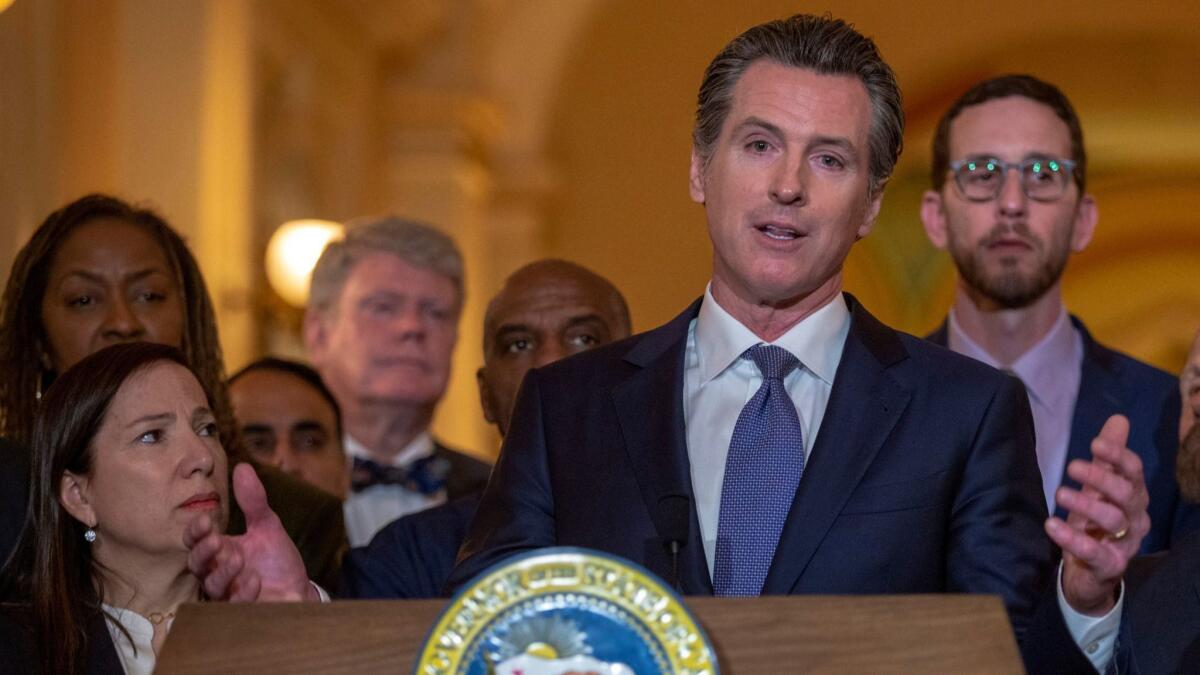Newsom can grant reprieves, but other steps might face legal challenges, experts say

Gov. Gavin Newsom has full legal authority to spare the lives of death row inmates during his term in office, but he could be challenged for discarding the state’s death penalty protocol and shuttering the execution chamber, legal analysts said Wednesday.
Newsom signed an executive order Wednesday granting reprieves to the 737 inmates on California’s death row. He also said he would withdraw a single-drug protocol for executions and shut down the execution chamber at San Quentin.
UC Berkeley Law Professor Elisabeth Semel, who directs a death penalty clinic, said Newsom was legally entitled to grant the reprieves.
“Absolutely, without a doubt,” she said. “The governor of the state of California has the power to grant reprieves. Period. Full stop.”
But she said it “remains to be seen” whether his decision to withdraw the protocol and shut down the execution chamber might be vulnerable in a lawsuit.
“The governor understands that may be a complicated legal question, but he is prepared if somebody wants to sue him,” she said. “He is prepared to face that lawsuit.”
She said there were “serious problems” with the protocol, and she believed Newsom had the right to say he was not prepared to defend it.
Kent S. Scheidegger, legal director of the Criminal Justice Legal Foundation, agreed that Newsom could grant reprieves but said the state is required to maintain a protocol and a death chamber under Proposition 66, the successful 2016 ballot measure intended to speed up executions.
“He is just flagrantly violating the law,” said Scheidegger, the primary author of Prop. 66.
That measure requires the state to be ready to execute inmates, he said.
“We could challenge it, and I am pretty sure we would win,” he said. “But is there any point given that we can’t challenge a reprieve? We have to think about that.”
Newsom’s action leaves the death penalty law in place. Prosecutors may still seek death sentences, and appellate courts will continue to have to review them.
These are the 737 inmates on California’s death row »
Scheidegger said a victim has the right under Prop. 66 to challenge Newsom’s decision to discard the protocol and shut down the death chamber.
Atty. Gen. Xavier Becerra, who has said he supports the death penalty, also could challenge it, Scheidegger said, adding, “But there is no chance in hell of that.”
He said Becerra has been “dragging his feet” in litigation to restart executions. “So for the attorney general to take any positive action would astonish me,” he said.
Becerra, in a prepared statement, praised Newsom for his “bold” action.
“We must always strive to sustain a criminal justice system that reflects our values of fairness and equality,” Becerra said. “Governor Gavin Newsom’s action today represents a bold, new direction in California’s march toward perfecting our search for justice.”
Death penalty prosecutions have been declining in California and in the nation as prosecutors have become more selective in charging, and homicide rates have declined.
San Luis Obispo County Dist. Atty. Dan Dow said Newsom’s executive order would not affect his decisions on whether to seek the death penalty in the future.
“This office will continue to look at it on a case-by-case basis,” Dow said. “The governor cannot strike the law, and death sentences are still valid.”
He said he expected litigation and would be prepared to join a fight against Newsom’s action if it were legally feasible.
“Right now, it is so early,” he said. “We are all trying to analyze where we are where we might be able to go.”
Stanford Law Professor Robert Weisberg, an expert in criminal law, said Newsom obviously was carefully advised on the law. Weisberg said he doubted a challenge would succeed.
As governor, Newsom oversees the Department of Corrections and Rehabilitation, which is in charge of executions, Weisberg noted. Newsom is merely directing employees not to perform one of their assigned tasks, Weisberg said.
“He is acting as the boss of CDCR,” he said.
Santa Clara Law Professor Emeritus Gerald F. Uelmen said it made no sense to challenge the withdrawal of the protocol.
“If he has a reprieve in place, the protocol is moot,” said Uelmen, who ran a state commission several years that examined the administration of the death penalty.
The commission’s report found the system was deeply dysfunctional and required a massive infusion of money.
Uelmen said Newsom might be able to get the Legislature to put another measure on the ballot to end capital punishment entirely.
Voters have narrowly rejected past measures to abolish it and narrowly supported Proposition 66.
“It is just a few holdout counties that are still using it,” he said.
Scheidegger said death penalty advocates are not prepared to give up.
“I wouldn’t say it is over yet,” he said. “We have to decide what is feasible to do.”
Twitter: @mauradolan
More to Read
Sign up for Essential California
The most important California stories and recommendations in your inbox every morning.
You may occasionally receive promotional content from the Los Angeles Times.











